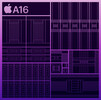Apple A16 Bionic vs Intel Core i5-6300U
Apple A16 Bionic
► remove from comparison
The Apple A16 Bionic is a System on a Chip (SoC) from Apple that is found in the iPhone 14 Pro (2022) models. It offers 6 cores divided in two performance cores (codename Everest, up to 3.46 GHz) and four power-efficiency cores (codename Sawtooth, up to 2.02). According to Apple, the most improvements were made to the efficiency cores and the improved memory bandwidth (+50% thanks to LPDDR5). According to the die analysis from angstronomics, the e-core cluster still has the same 4 MB L2 cache, but the p-cores now offer 16 MB L2 cache. The SLC (System Level Cache) however seems to be reduced to 24 MB.
The Neural Engine still offers 16 cores and offers an increased performance of 17 TOPS (vs. 15.8 of the A15) for AI tasks. The integrated graphics engine still offers 5 cores and benefits mostly from the higher memory bandwidth. The new display engine supports adaptive refresh rates down to 1 Hz, the new always-on display, and improved anti-aliasing (for the dynamic island animations).
The CPU performance only shows small improvements to the last generation (Apple A15 Bionic). Still, the A16 is by far the fastest mobile CPU for smartphones and leaves e.g. the Snapdragon 8+ Gen 1 easily behind (in Geekbench 5.4 single- and multi-thread tests).
The chip is manufactured on the modern 4nm process at TSMC and integrates nearly 16 billion transistors (compared to the 15.8 billion of the A15 and 11.8 of the A14). Apple emphasized on efficiency and e.g. mentioned 20% power savings for the big performance cores and class-leading efficiency of the e-cores.
Intel Core i5-6300U
► remove from comparison
The Intel Core i5-6300U is an ULV (ultra low voltage) dual-core SoC based on the Skylake architecture and has been launched in September 2015. The CPU can be found in ultrabooks as well as normal notebooks. In addition to two CPU cores with Hyper-Threading clocked at 2.4 - 3.0 GHz (2 cores: max. 2.9 GHz), the chip also integrates an HD Graphics 520 GPU and a dual-channel DDR4-2133/DDR3L-1600 memory controller. The SoC is manufactured using a 14 nm process with FinFET transistors.
Architecture
Skylake replaces both Haswell and Broadwell and brings the same microarchitecture in every TDP class from 4.5 to 45 W. The extensive improvements of the Skylake design include increased out-of-order buffers, optimized prefetching and branch prediction as well as additional performance gains through Hyper-Threading. Overall, however, performance per clock has been increased by only 5 to 10 percent (compared to Haswell) respectively under 5 percent (compard to Broadwell), which is quite modest for a new architecture ("Tock").
Performance
According to the specified clock rates and the improved architecture, the Core i5-6300U should perform similar to (or slightly above) the former Core i7-5500U (Broadwell, 15 W). Thus, the CPU has sufficient power for office and multimedia purposes as well as more demanding applications and multitasking.
Graphics
The integrated graphics unit called HD Graphics 520 represents the "GT2" version of the Skylake GPU (Intel Gen. 9). The 24 Execution Units, also called EUs, are clocked at 300 - 1000 MHz and offer a performance somewhere in range of a dedicated GeForce 820M. Games of 2015 can thus be played smoothly in low settings. For more information about performance and features, check our page for the HD Graphics 520.
Power Consumption
Specified at a TDP of 15 W (including CPU, GPU and memory controller), the CPU is best suited for small notebooks and ultrabooks (11-inches and above). Optionally, the TDP can be lowered to 7.5 watts (cTDP down), reducing both heat dissipation and performance and allowing even more compact designs.
| Model | Apple A16 Bionic | Intel Core i5-6300U | ||||||||||||||||||||||||||||||||||||||||
| Codename | Crete | Skylake | ||||||||||||||||||||||||||||||||||||||||
| Series | Apple Apple A-Series | Intel Core i5 | ||||||||||||||||||||||||||||||||||||||||
| Clock | 2020 - 3460 MHz | 2400 - 3000 MHz | ||||||||||||||||||||||||||||||||||||||||
| L2 Cache | 20 MB | 512 KB | ||||||||||||||||||||||||||||||||||||||||
| L3 Cache | 24 MB | 3 MB | ||||||||||||||||||||||||||||||||||||||||
| Cores / Threads | 6 / 6 | 2 / 4 | ||||||||||||||||||||||||||||||||||||||||
| Transistors | 16000 Million | |||||||||||||||||||||||||||||||||||||||||
| Technology | 4 nm | 14 nm | ||||||||||||||||||||||||||||||||||||||||
| Features | ARMv8 Instruction Set, Machine Learning Controller, 16-Core Neural Engine, Secure Enclave, Advanced Image Signal Processor | Dual-Channel DDR3L-1600/DDR4-2133 Memory Controller, HyperThreading, AVX, AVX2, Quick Sync, Virtualization, AES-NI, vPro, TXT | ||||||||||||||||||||||||||||||||||||||||
| iGPU | Apple A16 GPU 5-Core | Intel HD Graphics 520 (300 - 1000 MHz) | ||||||||||||||||||||||||||||||||||||||||
| Architecture | ARM | x86 | ||||||||||||||||||||||||||||||||||||||||
| Announced | ||||||||||||||||||||||||||||||||||||||||||
| Series: Core i5 Skylake |
| |||||||||||||||||||||||||||||||||||||||||
| L1 Cache | 128 KB | |||||||||||||||||||||||||||||||||||||||||
| TDP | 15 Watt | |||||||||||||||||||||||||||||||||||||||||
| Die Size | 99 mm2 | |||||||||||||||||||||||||||||||||||||||||
| max. Temp. | 100 °C | |||||||||||||||||||||||||||||||||||||||||
| Socket | BGA | |||||||||||||||||||||||||||||||||||||||||
| $281 U.S. | ||||||||||||||||||||||||||||||||||||||||||
| Manufacturer | ark.intel.com |
Benchmarks
Average Benchmarks Apple A16 Bionic → 100% n=3
Average Benchmarks Intel Core i5-6300U → 45% n=3
* Smaller numbers mean a higher performance
1 This benchmark is not used for the average calculation












